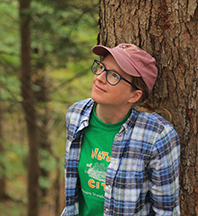Week of March 12, 2023 – March 18, 2023
by Anna Stunkel , Environmental Educator
One of my favorite signs of spring starts on March 1, when the hawkwatch season begins at Derby Hill Bird Observatory and many other North American hawkwatches. A great variety of raptors, or birds of prey, can be seen from this hill overlooking Lake Ontario.Spring raptor migration in the northeast includes hawk, vulture, falcon, eagle, harrier, and Osprey movement.
Hawkwatching is a pastime of patience and anticipation. As the hawkcounter at Derby Hill in 2017 and 2018, I lived in a cozy cottage overlooking stunning views of Lake Ontario. I woke each day with the raptors from March 1 to May 31, counting from around sunrise to sunset on the busiest days. From double digits to triple digits the daily counts climb as spring goes on, with a nice diversity of hawks like Red-tailed, Red-shouldered, and Rough-legged Hawks arriving first. Sharp-shinned and Cooper’s Hawks increase as the season goes on, along with Bald Eagles. Finally, waves of Turkey Vultures pass the lookouts and daily counts break into the thousands. By mid- to late April, Broad-winged Hawks arrive on their journey north from South America. On my busiest counting day, May 1, 2018, I counted 9,628 raptors!
Why is Derby Hill such an amazing spot for witnessing raptor migration? As they move north, many birds become concentrated at the southeastern corner of Lake Ontario, and are faced with a choice: fly as much as 30 miles across the easternmost area of the lake, or turn the corner and stay over land where prey and resting sites are accessible. By the time many birds reach Derby Hill, they’ve already made the decision to follow the shoreline while passing points further west. This creates a “traffic jam” in the sky, treating observers to a spectacle of raptors circling on thermals and gliding north overhead.
In combination with long-term data from other hawkwatch sites and nesting and wintering surveys, we can learn a lot about how population trends and migration routes are changing. Red-tailed Hawk counts have been trending downwards at many northern hawkwatch sites. This may be due to climate change, which reduces the need for these birds to migrate long distances and strains prey availability since so many hawks are staying up north. In good news, Bald Eagle numbers have drastically increased after DDT was banned. For about the first two decades of counting at Derby Hill, less than 100 Bald Eagles per season were recorded. Nowadays, it’s not unusual to see close to 1,000 or more passing through in one season.
To keep up to date with the counts and to learn more about Derby Hill, select “Derby Hill Bird Observatory” at hawkcount.org/sitesel.php. The data summaries column on the left side of the page has past reports dating all the way back to 1979. Also, keep an eye on our website at baltimorewoods.org for information coming soon about an April Derby Hill field trip!


